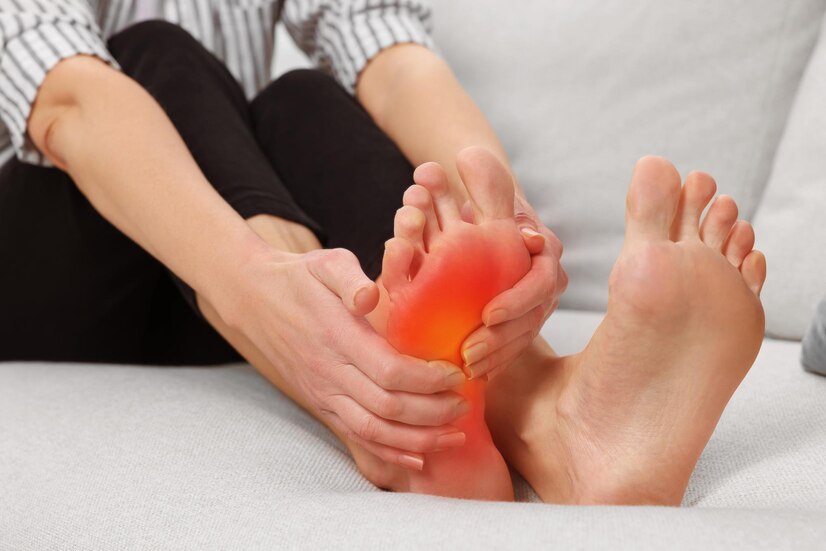Foot pain, often underestimated, can significantly impact daily life. From standing to walking, our feet bear the brunt of our activities. Understanding the causes and remedies for foot pain is crucial for overall well-being. In this article, we delve into various aspects of foot pain, providing insights, remedies, and preventive measures.
Are you experiencing foot pain? Discover comprehensive insights and solutions to alleviate discomfort in this detailed guide.
Understanding Foot Anatomy and Function
The foundation of comprehending foot pain lies in understanding its anatomy and function. Our feet are complex structures composed of bones, muscles, tendons, ligaments, and nerves. Each component plays a vital role in supporting body weight, maintaining balance, and facilitating movement.
Bones of the Foot
The foot consists of 26 bones, including the tarsal, metatarsal, and phalangeal bones. These bones form the arches of the foot, providing stability and flexibility.
Muscles and Tendons
Muscles and tendons work in harmony to move the foot and maintain its structure. The calf muscles, Achilles tendon, and intrinsic foot muscles are instrumental in foot movement and stability.
Arches of the Foot
Three primary arches – medial, lateral, and transverse – distribute body weight evenly during standing and walking, absorbing shock and providing propulsion.
Plantar Fascia
The plantar fascia is a thick band of tissue that supports the arch of the foot. Inflammation of this tissue, known as plantar fasciitis, is a common cause of heel pain.
Common Causes of Foot Pain
Understanding the root causes of foot pain is essential for effective management. Various factors contribute to foot discomfort, ranging from structural abnormalities to lifestyle choices.
Plantar Fasciitis
Plantar fasciitis, characterized by heel pain, often worsens with prolonged standing or walking. Tight calf muscles, high arches, or improper footwear can exacerbate this condition.
Flat Feet
Flat feet, or pes planus, occur when the arches collapse, leading to overpronation. This can result in pain and fatigue, especially during weight-bearing activities.
Overuse Injuries
Repetitive stress on the feet, such as running or jumping, can cause overuse injuries like stress fractures, tendonitis, or bursitis.
Footwear Choices
Ill-fitting shoes or those lacking adequate support can strain the feet, leading to discomfort and pain. High heels, in particular, alter biomechanics, increasing the risk of foot problems.
Preventive Measures and Home Remedies
Taking proactive steps to prevent foot pain is key to maintaining foot health and mobility. Simple lifestyle changes and self-care practices can alleviate discomfort and reduce the risk of future issues.
Proper Footwear Selection
Investing in supportive, well-fitting shoes is paramount for foot health. Choose footwear with cushioning, arch support, and a wide toe box to accommodate natural foot shape.
Stretching and Strengthening Exercises
Regular stretching and strengthening exercises can improve foot flexibility, muscle strength, and overall function. Focus on calf stretches, toe curls, and ankle circles to promote mobility and reduce tension.
Orthotic Inserts
Orthotic inserts provide additional support and cushioning, redistributing pressure and relieving strain on the feet. Custom orthotics are tailored to individual foot anatomy, offering personalized comfort and stability.
Rest and Ice Therapy
Resting the feet and applying ice packs can alleviate inflammation and pain associated with overuse injuries. Elevating the feet and using ice therapy for 15-20 minutes several times a day can promote healing and reduce swelling.
Professional Treatment Options
In some cases, professional intervention may be necessary to address persistent foot pain or underlying conditions. Healthcare professionals offer a range of treatment options tailored to individual needs.
Physical Therapy
Physical therapy sessions focus on improving foot mechanics, flexibility, and strength through targeted exercises and manual techniques. Therapists also educate patients on injury prevention and self-care strategies.
Custom Orthotics
Podiatrists may prescribe custom orthotics to correct biomechanical imbalances and alleviate pressure on specific areas of the foot. These orthotic devices provide personalized support and enhance foot function.
Corticosteroid Injections
For severe inflammation and pain, corticosteroid injections may be recommended to reduce swelling and alleviate discomfort. These injections target inflamed tissues, providing temporary relief from symptoms.
Surgical Interventions
In rare cases where conservative treatments fail to resolve foot pain, surgical interventions may be considered. Procedures such as plantar fascia release or bunionectomy aim to address structural abnormalities and restore foot function.
Conclusion
Foot pain is a common complaint that can significantly impact daily activities and quality of life. By understanding its causes, preventive measures, and treatment options, individuals can take proactive steps to alleviate discomfort and maintain optimal foot health. Whether through lifestyle modifications, self-care practices, or professional interventions, prioritizing foot wellness is essential for overall well-being.
FAQs
What are the best shoes for alleviating foot pain?
Opt for shoes with ample cushioning, arch support, and a wide toe box to accommodate foot shape and reduce pressure points.
Can foot pain be caused by poor posture?
Yes, poor posture can contribute to foot misalignment and biomechanical issues, leading to pain and discomfort over time.
Is it normal to experience foot pain during pregnancy?
Pregnancy-related weight gain and hormonal changes can increase strain on the feet, resulting in discomfort and swelling. Wearing supportive footwear and practicing gentle exercises can help alleviate symptoms.
How can I prevent foot pain while standing for long periods?
Take regular breaks to rest and stretch your feet, wear supportive shoes with cushioning, and consider using anti-fatigue mats or insoles to reduce strain.
Are high heels bad for foot health?
High heels alter foot biomechanics, placing excessive pressure on the forefoot and toes. Prolonged wear can lead to various foot problems, including bunions, corns, and plantar fasciitis.
Can foot pain be a sign of a more serious underlying condition?
Yes, persistent or severe foot pain may indicate underlying conditions such as arthritis, neuropathy, or stress fractures. It is essential to consult a healthcare professional for proper diagnosis and treatment.







